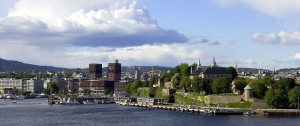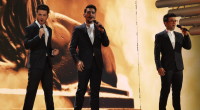
The Norwegan capital, Oslo, was founded in the year 1048 by king Harald Harderåde. Later excavations however suggest that people have been living in the area much longer.
During the reign of king Håkan the 5th Magnusson, Oslo experienced a boom with many new important buildings being built such as Akershus fortress and the Maria church. The king then decided to permanently live there and have his “kongsgaard” (Scandinavien for carsel) built there. The title “capital of Norway” wasn’t given to the city before the year 1314, where the city’s fortress “Akershus” stopped a rebel attack led by the earl of Sødermannland who wanted to seize the throne of Norway.
He was not the first king of Norway to have residence in Oslo. Before him king Sigurd Jorsalfar (1090-1130) lived in there.
In the absence of a Norwegian king, the Danish queen Magrethe, in the year 1388, was chosen to be monarch over both Denmark and Norway, and in 1395 she was also chosen to rule over Sweden, in what is known as the Kalmer union. The union lasted until 1524 where Sweden broke out of the alliance.
During the Danish/Norwegian double monarchy, Oslo slowly lost it’s importance. Because everybody who wanted to become something moved to Copenhagen (Capital of Denmark), and the period the Norwegians call “the 400 years of darkness” took its beginning.
Several imporant events took place in 1624 in Oslo. The city’s buildings, which where mainly built in wood, burned down. In fact some say that Oslo has burnt down about 14 times , the last time in 1716 where the citizens burnt it down to prevent the Swedish Karl the 12th and his troops getting any kind of shelter. This time the Danish king Christian IV gave the order to rebuild the city a bit to the east of its original location, so it could be a part of the complex around Akershus. This time using bricks for the houses instead of wood and renaming it to Christiania. Between 1877 and 1925 the spelling was changed to Kristiania.
As a result of the Napoleonic wars Denmark was, during the Wianna congress 1814-15, forced to hand over Norway to Sweden.
The Norwegians did not like to be traded between countries, they wanted their full independence instead. To achive this, they asked the Danish prince Christian Frederik to come to Norway as there new king. A new war broke out between Norway and Sweden, the first short one was i 1808, and again Norway won on the battelfield, but European intervention forced Norway to accept the decision. The result for Norway was some sort of independence for Norway, but still with a Swedish king. All major decisions would still be made together with the Sweden.
In 1880`s and 90`s things started to move faster in Oslo, still called Kristiania. The city attracted more inhabitants and politicians and common people started to talk more openly about a Norwegian breakup with Sweden. Eventually the cry for independence became so loud that Sweden and Norway split up into two independent countries in 1905. A Danish prince, this time Carl, became the new Norwegian king under the name King Haakon VII and Kristiania was to be the capital.
Recent research have revealed somo interesting new facts about the break up, which may have not been so peaceful as originally believed. Norwegian patriots had started to gather arms to free Norweay by force! I only hope that we soon will hear more about that.
Twenty years after the restoration of the kingdom of Norway, on January 1st 1925, Kristiania changed it’s name back Oslo. There are several opinions of the true meaning of the name, but most historians agree that it comes from the old Norwegian language and combines the words “os” and “lo”, which means “the plain of the gods”
In the early morning hours of the 9th of april 1940 German forces attached Norway, taking the southern parts quite easily while fighting went on for weeks in the hills and mountains. In the Oslo fiord the fortress “Oscarsberg” refused to surrender, opening fire on the Nazi warships sinking the cruser “Blucher”. It shows how a country, that has been under foreign control for many centuries does not give up so easily.
After the second World War ended in 1945, Oslo along with the rest of Norway have experience a fast development. From being a small and relatively country, to now were it flourish in many ways with thanks to the North Sea oil, but also because of the soul and hart of every Norwegian. And Oslo now takes its rightful place among the capitols in this world.
If you get tired of listening to Eurovision music, watching (videos of ) press conferences and dress rehearsals or visit the city some other time, here you have a handful of suggestions to what else to do in Oslo.
You could visit the Munch museum, Akershus fortress, City Hall, Nobel peace centre or Norway’s resistance museum. For more, check VISITOSLO.com, there you’ll find a lot of different places to go, or you could simply just go outside city limits a see the wonderful Norwegian nature. It’s your choice.



















